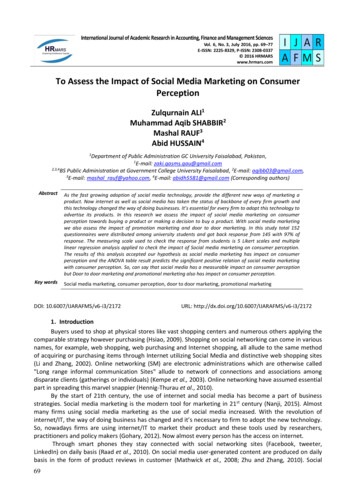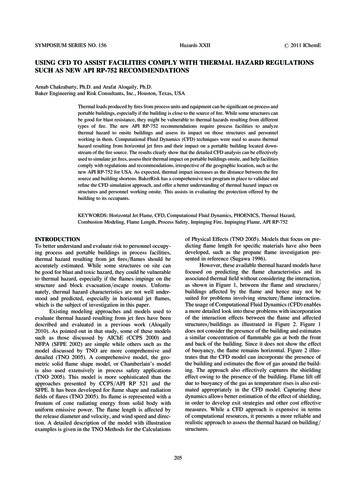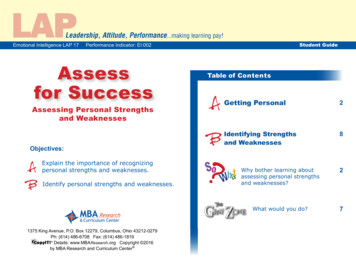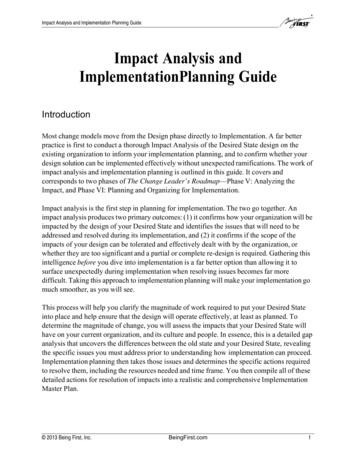
Transcription
International Journal of Academic Research in Accounting, Finance and Management SciencesVol. 6, No. 3, July 2016, pp. 69–77E-ISSN: 2225-8329, P-ISSN: 2308-0337 2016 HRMARSwww.hrmars.comTo Assess the Impact of Social Media Marketing on ConsumerPerceptionZulqurnain ALI1Muhammad Aqib SHABBIR2Mashal RAUF3Abid HUSSAIN41Department of Public Administration GC University Faisalabad, Pakistan,1E-mail: zaki.qasms.qau@gmail.com2,3,4BS Public Administration at Government College University Faisalabad, 2E-mail: aqibb03@gmail.com,3E-mail: mashal rauf@yahoo.com, 4E-mail: abidh5581@gmail.com (Corresponding authors)AbstractKey wordsAs the fast growing adoption of social media technology, provide the different new ways of marketing aproduct. Now internet as well as social media has taken the status of backbone of every firm growth andthis technology changed the way of doing businesses. It’s essential for every firm to adopt this technology toadvertise its products. In this research we assess the impact of social media marketing on consumerperception towards buying a product or making a decision to buy a product. With social media marketingwe also assess the impact of promotion marketing and door to door marketing. In this study total 152questionnaires were distributed among university students and got back response from 145 with 97% ofresponse. The measuring scale used to check the response from students is 5 Likert scales and multiplelinear regression analysis applied to check the impact of Social media marketing on consumer perception.The results of this analysis accepted our hypothesis as social media marketing has impact on consumerperception and the ANOVA table result predicts the significant positive relation of social media marketingwith consumer perception. So, can say that social media has a measurable impact on consumer perceptionbut Door to door marketing and promotional marketing also has impact on consumer perception.Social media marketing, consumer perception, door to door marketing, promotional marketingDOI: 10.6007/IJARAFMS/v6-i3/2172URL: http://dx.doi.org/10.6007/IJARAFMS/v6-i3/21721. IntroductionBuyers used to shop at physical stores like vast shopping centers and numerous others applying thecomparable strategy however purchasing (Hsiao, 2009). Shopping on social networking can come in variousnames, for example, web shopping, web purchasing and Internet shopping, all allude to the same methodof acquiring or purchasing items through Internet utilizing Social Media and distinctive web shopping sites(Li and Zhang, 2002). Online networking (SM) are electronic administrations which are otherwise called"Long range informal communication Sites" allude to network of connections and associations amongdisparate clients (gatherings or individuals) (Kempe et al., 2003). Online networking have assumed essentialpart in spreading this marvel snappier (Hennig-Thurau et al., 2010).By the start of 21th century, the use of internet and social media has become a part of businessstrategies. Social media marketing is the modern tool for marketing in 21 st century (Nanji, 2015). Almostmany firms using social media marketing as the use of social media increased. With the revolution ofinternet/IT, the way of doing business has changed and it’s necessary to firm to adopt the new technology.So, nowadays firms are using internet/IT to market their product and these tools used by researchers,practitioners and policy makers (Gohary, 2012). Now almost every person has the access on internet.Through smart phones they stay connected with social networking sites (Facebook, tweeter,LinkedIn) on daily basis (Raad et al., 2010). On social media user-generated content are produced on dailybasis in the form of product reviews in customer (Mathwick et al., 2008; Zhu and Zhang, 2010). Social69
International Journal of Academic Research in Accounting, Finance and Management SciencesVol. 6 (3), pp. 69–77, 2016 HRMARSnetworking sites take the central stage in the current environment of e marketing (Fue et al., 2009). Theuse of Social media for marketing enhanced the brand popularity (de Vries et al., 2012). Social mediaprovide the opportunity for consumer to consult with buyer instantly (Christodoulides and Jevons, 2011;Christodoulides, 2009) and express their perceptions with each other’s. Other marketing tools likepromotional marketing, TV advertisement and door to door selling is expensive for small firm due to smallamount of budget which use on human resource and time constrains. So, social media marketing is lesscostly and time saving as compared to other marketing tools (Makesh, 2013).A noticeable increase was seen in the use of social media as a marketing tool among Fortune 500companies of the world. According to a study which is conducted by the University of MassachusettsDartmouth in 2012, there are 73 percent of these companies have an official account on Twitter, while 66percent have Facebook page (Barnes et al., 2012). Now Social media marketing has become an importanttool for marketing, so this topic has gained more attention of researchers. This topic will assess the impactsocial media on consumer perceptions.1.1. Problem statementIn the recant years social media marketing has emerged as a new marketing tool. The aim of theorganizations is to enhance the profitability by using the effective marketing strategies. Furthermore themain focus of every firm is to maximize the profitability and reduction of cost of production. Every firm usedifferent social media for marketing like Facebook, twitter and other media. Internet is in the access ofalmost every person who is using a mobile phone as the introduction of 3G/4G services. So, this rapidgrowth of internet is a signal towards using internet as a marketing tool and its nice opportunity for anyfirm to change the consumer perception through social media marketing.1.2. RationaleThe main objective to study this topic is that to check the social media impact on consumerperception. Now days basically the era of technology and almost every person of country has easily accessof internet and social media websites. So, social media changes the perception of people throughout thecountry. Before the social media arrival firms used door to door selling and now days almost every firmused social media for increasing their selling and get maximum profit. Due to social media people havemany alternatives of brands. In past people hardly know about few brands but now days people awaremany choices of brands due to advertisement of brands on social media. So, social media has greaterimpact on consumer behavior as compared to other marketing tools thus the focus to study on this topic.1.3. Objectives of the Study1. To Assess the role of Social Media Marketing as an emerging marketing tool2. To check the relationship between Social Media Marketing and consumer perception3. To find the relationship between door to door Marketing and consumer perception1.4. Conceptual FrameworkSocial Media MarketingPromotional MarketingConsumerPerceptionDoor to Door Marketing2. Literature review2.1. Social Media MarketingThe 21th century as the technology world, social networking sites have providing the place wheredifferent companies can increase their marketing campaigns and catch wide range of consumers. According70
International Journal of Academic Research in Accounting, Finance and Management SciencesVol. 6 (3), pp. 69–77, 2016 HRMARSto Hansen, Shneiderman, and Smith (2011), the technology of social media has created radically a newways of interacting the retailers and consumers. According to Harris (2009) there are indisputably hundredsof social media platforms (e.g. Social networking sites, discussion groups, blogs, wikis, podcasts, streamingvideos). As Chi (2011), said that social media marketing described as a “connection between brands andconsumers, while social media marketing is providing a way to consumers for social interaction andcentered networking.” As Hesse et al. (2009) said that now consumers are expecting to gain 24-hour accessto information by online applications and many other digital ways, they are also expecting 24-hourcustomer service as well as self-serve options through online sources. Now consumers want to leave thetraditional system for getting information and want to utilize latest technology. As Chi (2011), said thatsocial media marketing described as a “connection between brands and consumers, while social mediamarketing is providing a way to consumers for social interaction and centered networking.” Social mediahas gained the position as a primary source for choosing a product by the consumers (Cocktail Analysis,2012; Fleishman-Hillard, 2012).As (Kotler et al., 2010; Armstrong and Kotler, 2011) said that the rapid development in the socialmedia application has gained overwhelming majority in the Marketing practices. Companies marketperformance and the products of the companies influenced by the huge quantity of data and informationwhich are generated by users on internet (Kietzmann et al., 2011). By Social media analytics, companiesgain competitive advantages by assessing the competitor’s strategies, suppliers performance and consumerbehavior, Fan and Gordon (2014).2.2. Promotional marketingMany companies use some specific tools to take attention of people towards their product like pricediscounts, coupons, contests, etc. Sales promotion is a temporary action that uses to motivate the peoplefor increasing the products and services purchase (HorĖák et al., 2012). To the rapid growth in the product’ssales, price discounts are the most popular for the short term promotional marketing (Gendall et al., 2006).The increase in the stores traffic is measured as a result of price discounts. Price discounts build the goodrelationship of retailers and manufactures, and it make sure product of that particular brand is goodstocked and easily available on stores (Gendall et al., 2006; Liu et al., 2015). As Lu et al. (2013) said that dueto the product characteristics difference the role of discounts on products may have different effects onconsumer. Price and promotions has much influence on product sales especially short lives products (Chongand Ooi, 2008). In US almost 80 percent of people which use internet download brand coupons/offersbefore making any purchase (eMarketer, 2013). As Grewal et al. (2011) draw a link between promotionalintermediaries and dimension of completion in market. Promotional flyers are the most important tool forthe marketing of a product because these flayers effect the perception of customers and also the decisionsof the customer about buying a product heavily rely on these flayers (Arnold et al., 2001; MimouniChaabane et al., 2010). As Marshall and Leng (2002) said that Sales of a product increase on 10-50 percentdiscount offer instead of this there is no effect or little effect when a company offer discounts 60-70percent on a product. It means that in advertising you use different techniques to introduce your productbut in promotional tools you use different techniques to increase your product sales.2.3. Door to door marketingBasically direct marketing is that which creates the direct relationship between the organization orcompany and customers (Bird, 2000). The main objective of direct marketing is to increase their customers(Baier, 2003). Many professionals says that direct marketing is more capable way to attain the marketinggoals, gathering, examining and using information about actual and potential customers. One of the mostcurrent definition of direct marketing is “direct marketing is attractive system that a company use tomeasurable response and to achieve the deal in any position” (Lee and Johnson, 2005). Direct marketingcompanies basically focus on communication skills to attain the customer attention (Alturas, 2003).2.4. Consumer perceptionThe study of consumer perception is very important in present marketing scenario becauseconsumers are “KINGS OF MARKETS” (Khan and Velayutham, 2013). As compare to consumer preferences71
International Journal of Academic Research in Accounting, Finance and Management SciencesVol. 6 (3), pp. 69–77, 2016 HRMARSfor the distribution method or services perceived fit was found to be more important. Perceived fit meansfor a specific product how appropriate a certain channel of distribution is? (Morrison and Roberts, 1998).The influence on consumer behavior towards purchasing a good also based on trust. Social media siteshelps in building a trust by networking with consumers in e-commerce. On social networking sites Evendors also encourage consumers to come online and build their trust by networking with then (McCole etal., 2010). Members can become familiar with one another on different platforms where consumerssocially interact, providing a possible source of trust (Lu et al., 2010). This influences the users’ intention tobuy (Gefen, 2002). To gain batter consumer perception Social media marketing is highly effective becauseit is less costly as well as it also provides a larger number vendors that can increase the consumerconvenience (Ab Hamid, 2008). Social media marketing play a vital role to build a good consumerperception about the products (Kim et al., 2003). The quality of product also influences consumer’sperception. The consumer will pay the price if its quality is good (Amal Pramanic, regional business directorOral-B). Packaging is also direct links with the consumer perception. A product with outstanding packagingdesign also draws the attention of the consumer (Deepak Manchandra, manager packaging development,Dabur). Concluding current literature, it can deducted that whatever the marketing method is one shouldkeep in mind these factors which influences consumer perception (Chen, 2014).2.5. HypothesisH1: Social Media Marketing has significant impact on Consumer Perception.H2: Promotional Marketing has positive impact on Consumer Perception.H3: Door to Door Marketing has positive impact on Consumer Perception.3. Methodology of researchFor getting better understanding of the impact of social media on consumer behavior, the nature ofstudy is quantitative. The respondent of this study are the students. The study was conducted on thestudent of Management & Administrative Sciences in the Government college university Faisalabad, toassess the impacts of social media marketing on consumer perception.3.1. Population of StudyThe respondent of this study was 250 from GC University Faisalabad. Following is the sampling frameof population.Management & Administrative Sciences (GCUF)Public AdministrationSection 150Section 250Business AdministrationSection 150Section 250Section 3503.2. Sample SizeTo calculate the sample size, we use Yamane (1964) sample size calculation method. Sample size was145 students of respective departments.3.3. Sampling TechniqueSimple random sampling was used to collect data from student of GC University Faisalabad.3.4. Research InstrumentThe research instrument use in this study was structured questionnaire adopted from previousresearches. Social media marketing measured from 6 items adopted from Smith, T. M. (2014). Promotionalmarketing measured from 4 items adopted from Shallu and Gupta S. (2013). Door to door marketing72
International Journal of Academic Research in Accounting, Finance and Management SciencesVol. 6 (3), pp. 69–77, 2016 HRMARSmeasured from 4 items adopted from a survey of Consumer Utilities advocacy center (2011). Consumerperception is measured from 3 items adopted from Chen, L. (2014).3.5. Data collectionThe data was collected through structured questionnaire. 155 questionnaires distributed among thestudents and received back 145 questionnaires which were properly filled. 145 questionnaires are fairlyattempted with 94% response. Questions were asked on five point Likert scale stating “1” as Strongly Agreeand “5” as strongly disagree. To test the proposed hypothesizes, correlation & Regression analysis wasdone using SPSS 21.0.4. Results4.1. Demographic CharacteristicsTable 1. Demographic CharacteristicsDemographic 22.81060756.941.451.7Frequency and percentage of demographic variables (N 145).4.2. Reliability TestTable 2. Reliability indexScalesSocial Media MarketingPromotional MarketingDoor to Door MarketingConsumer 852AdoptedSmith, T. M. (2014)Shallu and Gupta, S. (2013)Consumer Utilities advocacy center (2011)Chen, L. (2014)4.3. Multiple linear regressionsThe result of this regression shows the effect of Social media marketing, Promotional Marketing,Door to Door marketing and consumer perception among the University Students in Faisalabad (N 145).To see the factors which influence consumer perception, multiple linear Regressions were impliedand see that social media marketing is influencing on consumer perception. Predictor of research wasSocial Media Marketing, Promotional Marketing and Door to Door Marketing. The results indicated asignificant regression model where p .001 and model summary explained that 37% variation by thepredictors on measuring variable. Independent Variables that have shown statistically significant relationwith Consumer Perception were: Social Media Marketing (p .01), Promotional Marketing (p .01) and Doorto Door Marketing (p .05).FactorsSocial Media MarketingPromotional MarketingDoor to Door MarketingR squareAdj. R squareStandard error73Consumer Perception.135*.150*.680**.379.3571.612
International Journal of Academic Research in Accounting, Finance and Management SciencesVol. 6 (3), pp. 69–77, 2016 HRMARSNote: *Beta is significant at p value 0.01**Beta is significant at p value 0.054.4. Regression equationY bo b1X1 b2X2 b3X3 E(1)Consumer perception 10.346 .390(Social media marketing) .190(Promotional marketing) .55(Door todoor Marketing) EAs we have to check the influence of social media marketing on consumer perception is eitherpositive or negative? So, the question asked in questionnaire regarding to social media marketing hasfollowing results shown in pie charts.Do you think consumer's perceptions of a brandchanges by social media marketing activities?2% 13%Strongly AgreeAgree19%Neutral26%40%DisagreeStrongly DisagreeContent should be present which consumersexpect to see from a brand on social media.12% 13%13%Strongly AgreeAgreeNeutral33%29%DisagreeStrongly DisagreePeople mostly buy which brand posts are mostpopular.Strongly Agree18%24%Neutral16%30%12%AgreeDisagreeStrongly Disagree74
International Journal of Academic Research in Accounting, Finance and Management SciencesVol. 6 (3), pp. 69–77, 2016 HRMARSSocial Media innovates the ways of advertisingproducts or services in an efficient manner.Strongly Agree24%13%Agree25%4%NeutralDisagree34%Strongly DisagreeSocial media outlets should be a brand utilizeto engage with consumers.11%Strongly Agree22%16%15%AgreeNeutral36%DisagreeStrongly DisagreeConsumers perceive information posted by theother consumers on brand’s social mediaoutlets to be trustworthy.10%Strongly Agree15%12%AgreeNeutral33%30%DisagreeStrongly Disagree5. ConclusionsAccording to the coefficient table which shows that all independent variables has impact onconsumer perception. In table beta value of social media marketing is 0.135. This shows that there is weakbut positive relationship between social media marketing and consumer perception. Promotionalmarketing beta value is 0.150 which also show that there is weak relationship between promotionalmarketing and consumer perception. Door to door marketing beta value is 0.680 which show that there ismoderate relationship between door to door marketing and consumer perception. So door to door sellinghas greatest beta value this variable has more impact on consumer perception rather than social media andpromotional tools. Results show that the hypothesis H1, H2 and H3 is accepted.75
International Journal of Academic Research in Accounting, Finance and Management SciencesVol. 6 (3), pp. 69–77, 2016 HRMARS6. Recommendations and managerial implicationsConsumer perception is the indicator that establish link between the consumer’s interest and actualpurchase of the consumer. This study identifies and incorporates various marketing tolls which influencethe consumer perception. Although the promotional and door to door marketing influence more thansocial media but the positive results of social media also show that it will become more influential incoming days because it is more helpful and advance technique of marketing for any organization topromote and give brand awareness to the customers. Regarding to brand awareness companies should create groups and home pages on social mediain order to target consumers and can easily influence consumer perception regarding to their products. Through social media marketing companies easily attract more consumers specially those realcontributors and engaging them into discussions which helps to bring more innovation in productsaccording to consumer demands. Social media marketing also helps in the long term as consumer establish more and more trustand perceived value and when consumers have needs, the companies has high likelihood of a consumer topurchase a product . Being active on social media helps to influence more consumer perception because thing whichare new, distinctive and innovative are consider more by people. Social media in-built tools such as sending messages and regular newsletters to users containingthe newest information regarding new products helps to promote and give awareness to consumer aboutnew launched product. Consumer’s needs should be easily satisfied by companies by communicating and listening tothem, Providing care and services such as solving problems, taking suggestions, feedbacks and answeringqueries are effective ways to enhance the relationship between consumers and companies on social media.7. Future ResearchThe nature of the study is exploratory, in this paper data is gather only from student. It may bepossible that people from different fields have different response. It may analyze data from different fields.It may also possible preferences of people from one region or country to other region or country maydifferent towards using of social media and buying online product after seeing advertisement on socialmedia. The research conduct in different geographical area where social media is considered as morepopular technology may also have chance of positive results.References1. Abhamid, N.R. (2008).Consumers’ behavior towards Internet technology and Internet marketingtools. International Journal of Communications, 3(2).2. Chen, L. (2014). The influence of social media on consumer behavior: An empirical study onfactors influencing consumer purchase intention in China under the social media context. AARHUSUNIVERSITY. Retrieved April 20, 2016, from http://pure.au.dk/portal/files/75142267/The influence ofsocial media on consumer behavior.pdf3. Chi, Hsu-Hsien. (2011). Interactive Digital Advertising VS. Virtual Brand Community: ExploratoryStudy of User Motivation and Social Media Marketing Responses in Taiwan. Journal of InteractiveAdvertising, 12, 44-61.4. Chong, Alain Yee‐Loong, and Keng‐Boon Ooi. (2008). Adoption of Interorganizational SystemStandards in Supply Chains. Industrial Management & Data System, 108 (4), 529–547.5. Cocktail Analysis. (2012).Observatory of Social Networking Sites. Retrieved May 2, 2016 observatorio-de-redessociales6. De Vries, L., Gensler, S., Leeflang, E.S.H. (2012). Popularity of brand posts on brand fan pages: aninvestigation of the effects of social media marketing. Journal of Interactive Marketing, 26 (2), 83-91.7. E-Gohary, H. (2012). Factors affecting E-Marketing adoption and implementation in tourism firms:An empirical investigation of Egyptian small tourism organizations. Tourism Management, 33, 1256-1269.76
International Journal of Academic Research in Accounting, Finance and Management SciencesVol. 6 (3), pp. 69–77, 2016 HRMARS8.Majority of US internet users will redeem digital coupons in 2013. (2013). Retrieved May -2013/10103139. Fue, Z., Li, H. and Wenyu, D., (2009). Social factors in user perceptions and responses toadvertising in online social networking communities. Journal of Interactive Advertising, 10 (1).1-13.10. Gendall. P., Hoek, J., Pope, T. and Young, K. (2006). Message Framing Effects on PriceDiscounting. Journal of Product & Brand Management, 15 (7), 458–465.11. Grewal D., Ailawadi K.L., Gauri D., Hall K., Kopalle P. and Robertson, J. (2011). Innovations inretail pricing and promotions. Journal of Retailing, (1). S43-S52.12. Hanna, R., Rohm, A., and Crittenden. (2011). We’re all connected: The power of the social mediaecosystem. Business Horizons,54(3), 265-273.13. Hesse B.W. (2009). Enhancing consumer involvement in healthcare. In Parker J, Thornson, E.,Editors. Health Communication in the new media landscape. Springer Publishing; 2009: 119-141.14. Kietzmann, J.H., Hermkens, K., McCarthy, I.P. and Silvestre, B.S. (2011). “Social media? Getserious! Understanding the functional building blocks of social media”, Business Horizons, 54(3). 241-25115. Kim, S., Williams, R. and Lee, Y. (2003). Attitude toward online shopping and retail websitequality: A comparison of US and Korean consumers, Journal of International Consumer Marketing.16. Lee, M., and Johnson, C. (2005). Principles of Advertising: A Global Perspective. New York:Haworth Press17. Liu, M.J., Yannopoulou, N., Bian, X. and Elliott, R. (2015). Authenticity Perceptions in the ChineseMarketplace. Journal of Business Research 68 (1): 27–33.18. Lu, X., S. Ba, L. Huang, and Y. Feng. (2013). Promotional Marketing or Word-of-Mouth? Evidencefrom Online Restaurant Reviews. Information Systems Research 24 (3): 596–612.19. Makesh, N. (2013). E-marketing -- A New Concept. International Journal of scientific researchand management (IJSRM).50-5420. Mathwick, C., Wiertz, C., and De Ruyter, K. (2008). Social capital production in a virtualcommunity. Journal of Consumer Research, (34), 832–849.21. Marshall, R., and Seow, B.L. (2002). Price Threshold and Discount Saturation Point in Singapore.Journal of Product & Brand Management 11 (3):147–159.22. McCole, E., Ramsey, E. and Williams, J. (2010) Trust considerations on attitudes towards onlinepurchasing: the moderating effect of privacy and security concerns .Journal of Business Research, 63, (9-10),1018-1024.23. Mimouni-Chaabane, A. and Volle, P. (2010). Perceived benefits of loyalty programs: Scaledevelopment and implications for relational strategies. Journal of Business Research, 63(1), 32-37.24. Nanji, A. (2015). The Most Effective Social Networks for Marketing a Business in 2015 RetrievedMay 5, 2016 from: siness-in-2015#ixzz45Ghb27Nc.25. Raad, M., Yeassen A., G.M., Zaidan, BB. and Zaidan, AA. (2010). Impact of spam advertisementthrough email: A study to assess the influence of the anti-spam on the email marketing. African Journal ofbusiness Management, 4(11), 2362-2367.26. Smith T.M. (2014). Consumer Perceptions of a Brand's Social Media Marketing. Retrieved May6,2016 from: http://trace.tennessee.edu/utk gradthes/318427. Shallu and Gupta, S. (2013). Impact of Promotional Activities on Consumer Buying Behavior: AStudy of Cosmetic Industry. International Journal of Commerce, Business and Management. 2(6), 2319–282828. The consumer experience of door-to-door energy sales in Victoria. (2012, February 14).Retrieved April 24, 2016, from s-in-victoria-findings-from-a-cuac-survey/file29. Zhu, F., and Zhang, X. (2010). Impact of online consumer reviews on sales: The moderating roleof product and consumer characteristics. Journal of Marketing, 74, 133–148.77
2.3. Door to door marketing Basically direct marketing is that which creates the direct relationship between the organization or company and customers (Bird, 2000). The main objective of direct marketing is to increase their customers (Baier, 2003). Many professionals says that direct marketing is











